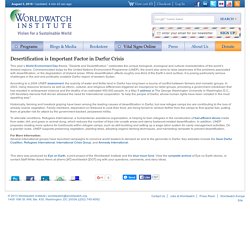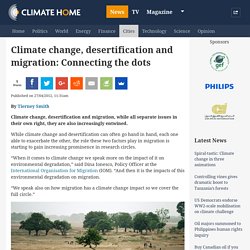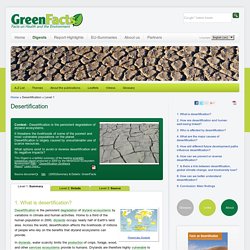

BBC Class Clips Video - Geography KS3 / GCSE: How animals and people adapt to live in the Arabian Desert. Teacher Notes Key Stage 3 This could be used to introduce students to the ecosystem of the desert and how people, plants and animals adapt to the conditions.

Students could be given a list of plants or animals and asked to decide which ones would be best suited to survive in these conditions. Students could look at the fennec fox, comparing it to other foxes and the adaptations they have made to survive in their particular biomes. This could be used alongside a study of the tundra biome. Key Stage 4. Would You Stay if Your Home Became a Desert? Surviving on wild seeds after failed harvests in Chad – in pictures. Allan Savory: How to fight desertification and reverse climate change. ArcGIS - World Atlas of Desertification. UNCCD - Desertification. Desert Adaptations. Desert Plant Survival. To survive, desert plants have adapted to the extremes of heat and aridity by using both physical and behavioral mechanisms, much like desert animals.

Plants that have adapted by altering their physical structure are called xerophytes. Xerophytes, such as cacti, usually have special means of storing and conserving water. They often have few or no leaves, which reduces transpiration. Phreatophytes are plants that have adapted to arid environments by growing extremely long roots, allowing them to acquire moisture at or near the water table. Other desert plants, using behavioral adaptations, have developed a lifestyle in conformance with the seasons of greatest moisture and/or coolest temperatures. Desert perennials often survive by remaining dormant during dry periods of the year, then springing to life when water becomes available. Most annual desert plants germinate only after heavy seasonal rain, then complete their reproductive cycle very quickly. Xerophytes Phreatophytes Perennials.
World Geography Games: Deserts. Desertification on Flipboard. Desertification is Important Factor in Darfur Crisis. This year’s World Environment Day theme, “Deserts and Desertification,” celebrates the unique biological, ecological and cultural characteristics of the world’s dryland regions.

Commemorated today by the United Nations Environment Programme (UNEP), the event also aims to raise awareness of the problems associated with desertification, or the degradation of dryland areas. While desertification affects roughly one-third of the Earth’s land surface, it is posing particularly serious challenges in the arid and politically unstable Darfur region of western Sudan. According to a 2004 UNEP assessment, the scarcity of water and fertile land in Darfur has long been a source of conflict between farmers and nomadic groups. In 2003, rising resource tensions as well as ethnic, cultural, and religious differences triggered an insurgence by rebel groups, provoking a government crackdown that has resulted in widespread violence and the deaths of an estimated 450,000 people. Climate change, desertification and migration: Connecting the dots.
By Tierney Smith Climate change, desertification and migration, while all separate issues in their own right, they are also increasingly entwined.

While climate change and desertification can often go hand in hand, each one able to exacerbate the other, the role these two factors play in migration is starting to gain increasing prominence in research circles. “When it comes to climate change we speak more on the impact of it on environmental degradation,” said Dina Ionesco, Policy Officer at the International Organisation for Migration (IOM). “And then it is the impacts of this environmental degradation on migration. “We speak also on how migration has a climate change impact so we cover the full circle.” Desertification: land degradation under a changing climate - Climatica. Today, 17th June, is the World Day to Combat Desertification, with an event being held by the United Nations Convention to Combat Desertification (UNCCD), and hosted at the World Bank in partnership with the Global Environment Facility (GEF), TerrAfrica and Connect4Climate.

The UNCCD have recently published a comprehensive report on the impacts of desertification. Here we look at what desertification is, how it is affected by climate change, and what this means for global populations. What is desertification? Desertification is a form of land degradation by which land becomes more arid. It’s definition is debated, but it generally refers to “the process of fertile land transforming into desert typically as a result of deforestation, drought, or improper/inappropriate agriculture” (Princeton University Dictionary). “Desertification is a silent, invisible crisis that is destabilizing communities on a global scale.”
From the United Nations Convention to Combat Desertification (UNCCD), 2014. Desertification Effects, Causes, And Examples : Top 10 List - Science HeathenScience Heathen. Desertification is a process of land-degradation by which a region becomes progressively drier and drier — eventually becoming desert.

Or, to put it another way — desertification is the process by which previously biologically productive land is transformed into wasteland. There’s actually currently something of a debate over the use of the term though. Scientific Facts on Desertification. Home » Desertification » Level 1 Context - Desertification is the persistent degradation of dryland ecosystems.

It threatens the livelihoods of some of the poorest and most vulnerable populations on the planet. Desertification is largely caused by unsustainable use of scarce resources. What options exist to avoid or reverse desertification and its negative impacts? 1. BBC Bitesize - 4th level People, place and environment - The Sonoran Desert - over-extraction of water. The Sahara: Facts, Climate and Animals of the Desert.
The Sahara is the world’s largest hot desert and one of the harshest environments on the planet.

It is third largest desert overall after Antarctica and the Arctic, which are cold deserts. At 3.6 million square miles (9.4 million square kilometers), the Sahara, which is Arabic for "The Great Desert," engulfs most of North Africa. Hot Deserts of the World.